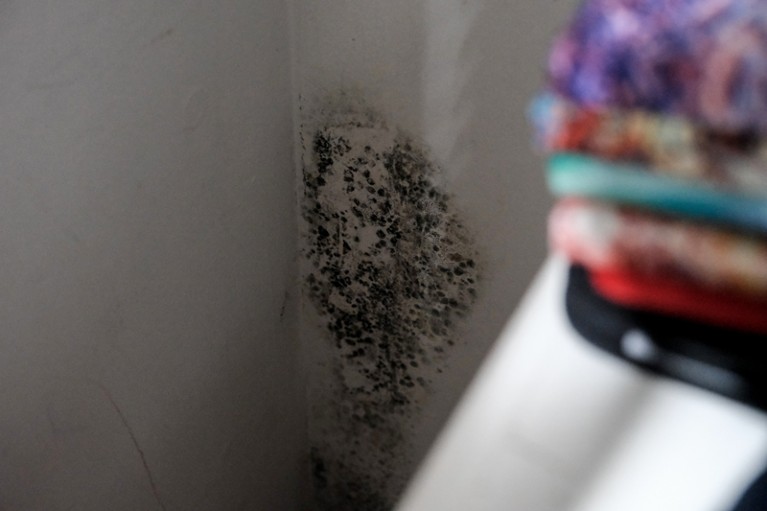
The World Health Organization’s most recent guidelines on damp and mould are from 2009.Credit: Michael A. McCoy/The Washington Post/Getty
The image of air pollution is often one of chimney stacks and smoggy cities. But this can be a misleading picture. Indoor air pollution killed more than 3 million people in 2020, almost as many as did its outdoor counterpart. And yet it has been mostly invisible to science, and to policy.
In a Comment article in Nature this week, three researchers describe how that needs to change. Christopher Whitty, the UK government’s chief medical adviser, and colleagues Deborah Jenkins and Alastair Lewis, show what researchers and policymakers must do to improve our understanding of, and ultimately to reduce, indoor air pollution. Most people spend 80–90% of their time indoors, in homes, schools and places of work, the authors observe. But, in contrast to detailed and legally enforceable national standards for outdoor pollution that exist in many parts of the world, indoor spaces are mostly not subject to similar air-quality controls.
Hidden harms of indoor air pollution — five steps to expose them
The authors are right to draw attention to something that has been neglected for too long. Progress is hampered by our ignorance of basic facts, such as what indoor air pollution actually consists of. It includes familiar compounds such as carbon monoxide and carbon dioxide from coal burning, and nitrogen oxides from natural-gas boilers. But there is also a multiplicity of other sources, for example chemicals from synthetic compounds in paints and fabrics, mould from damp buildings and viruses and bacteria from human breath. Researchers need to be doing more to understand how all of these circulate, how they interact with each other, their impact on human health and how they will be affected by climate change.
Although indoor air pollution is a global problem, the right strategies for combating it will vary between regions, countries and even localities. “Construction styles and materials, climate and energy sources, as well as behaviours and cultural practices, all affect indoor air”, the authors point out.
What’s clear, however, is that, just as poorer and marginalized people are disproportionately affected by bad outdoor air quality (A. Jbaily et al. Nature 601, 228–233; 2022), indoor air pollution is a source of inequality, too. In sub-Saharan Africa, for example, 700,000 people are estimated to have died from indoor air pollution in 2019, many of them from the effects of particles from indoor biomass stoves (B. Khavari et al. Nature Sustain. https://doi.org/grqrbg; 2023). Cleaner alternatives do exist, but their large-scale use needs a panoply of research-based interventions — from engineering and design to behavioural sciences.
In richer or colder countries, people on lower incomes tend to rely on gas or solid fuels for heating, or live in homes affected by damp and mould. Targeted interventions to improve air quality by, for example, incentivizing the switch to cleaner fuels, can be a win–win situation, with the happy complementary effect of assisting decarbonization, too. (The reverse is, perhaps, less true: interventions to improve energy efficiency by better insulating indoor environments might have a negative effect on air quality, a relationship that must be carefully examined.) But, as the authors write, “it is essential that decarbonization, building improvement and gains in indoor air quality are, as much as possible, delivered equitably across society.”
Indoor air pollution clearly needs to attract urgent attention from policymakers — the most recent guidelines from the World Health Organization on damp and mould were published in 2009. That’s where Whitty and colleagues’ article, coming from researchers who advise governments, will undoubtedly help. Ultimately, science must be better prepared for when it is called on to advise about the various strategies. Indoor air pollution should become as mainstream a public-health concern as its outdoor sibling, with all the requisite funding that flows towards it. This is one good intention that shouldn’t go up in a puff of smoke.

 Hidden harms of indoor air pollution — five steps to expose them
Hidden harms of indoor air pollution — five steps to expose them
 Air pollution: a global problem needs local fixes
Air pollution: a global problem needs local fixes
 A geospatial approach to understanding clean cooking challenges in sub-Saharan Africa
A geospatial approach to understanding clean cooking challenges in sub-Saharan Africa
 Air pollution exposure disparities across US population and income groups
Air pollution exposure disparities across US population and income groups
 An urgent health problem of indoor air pollution: results from a 15-years carbon monoxide poisoning observed study in Jinan City
An urgent health problem of indoor air pollution: results from a 15-years carbon monoxide poisoning observed study in Jinan City






